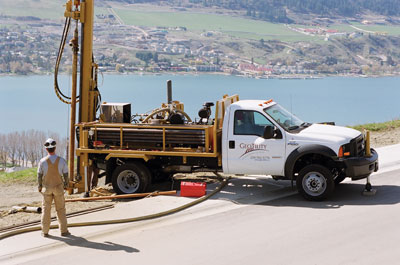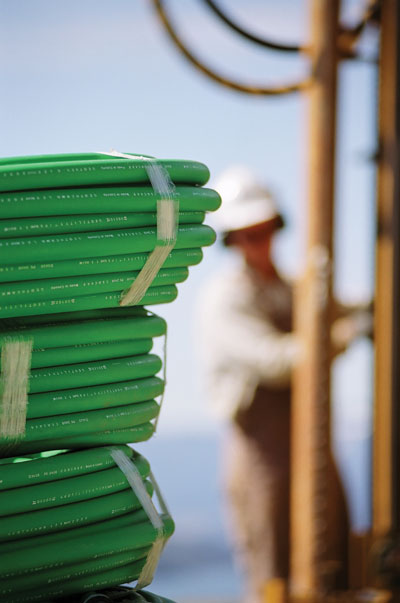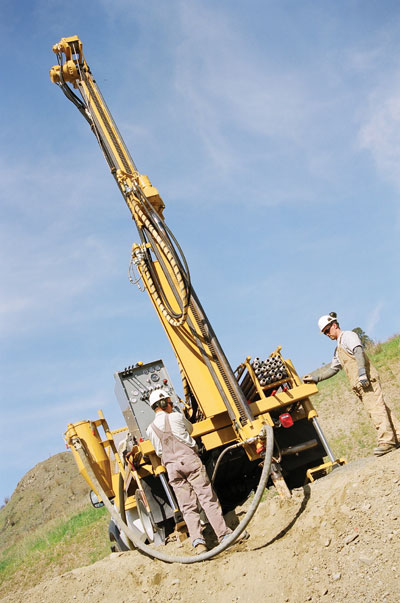
Features
Education
Research
Rules for success
Being an early bird helped GeoTility earn its wings
August 31, 2012 By Laura Aiken
Jim Leask got his start in heating and cooling in the early 1990s before turning his focus solely to geothermal in 1997.
Jim Leask got his start in heating and cooling in the early 1990s before turning his focus solely to geothermal in 1997. He was early in the game as far as strategic development of the industry goes in Canada. Natural Resources Canada commissioned Ground Source Heat Pump Market Development Strategy – Final Report by Marbek Resource Consultants in 1999.
 |
|
| GeoTility focuses on turnkey solutions for small and big jobs alike. All photos courtesy of GeoTility Advertisement
|
This report laid the groundwork for industry growth in Canada and paved the way for The Canadian GeoExchange Coalition’s formation in 2003. But information had been growing and been gathered for some time. For example, a research program assessing geothermal opportunities and resources in Canada ran from 1976 to 1986, reports the Centre for Energy.
Today, his company, GeoTility Geothermal Installations, has eight rigs, about 60 people on staff, two Canadian offices and one in Washington state. Jobs have their staff roaming across Western Canada and the American Pacific Northwest. Though there are other shareholders now, Leask is still the president. GeoTility has dedicated itself to a leadership role in geothermal, serving on several boards and memberships: he is a past board member of the Earth Energy Society of Canada and Okanangan Chapter, B.C. Sustainable Energy Association; a board member of GeoExchangeBC, Okanagan Environmental Industry Alliance, Thompson Okanagan Branch – Cascadia Chapter of the Canada Green Building Council; and a member of the International Ground Source Heat Pump Association, Canadian GeoExchange Coalition and B.C. Ground Water Association.
 |
|
| GeoTility has four divisions: engineering, drilling, heat pumps and service/maintenance. |
Stuart Yanow, P. Eng., LEED, CGD, is vice-president of this geothermal company, which has done a great job at figuring out how to make money and grow doing geothermal installations. Yanow worked in mechanical consulting and design, spending several years learning the geothermal industry and technology before joining GeoTility six and a half years ago.
Excluding the United States, Yanow says Geotility installs systems in about 25 to 50 homes per year and works on about 25 commercial projects, while noting that is a low estimate. Residential contracts make up about 25 per cent of its projects, says Yanow, who is seeing more and more utility companies going into the energy market and energy services departments pushing contracts to sell geothermal to school boards.
The Osoyoos Indian Band project is a particularly intriguing job. It’s the first geothermal district energy system to date for interior British Columbia. A district energy system centralizes heating or cooling for a community or commercial development. This system is being designed for the Senkulman Business Park, and will also service a new corrections facility being built. In all likelihood, the Vincor winery adjacent to this property will also hook up to the system, which will improve the efficiency, says Yanow.
“Vincor, a large industrial tenant, are going to connect their wastewater, opportunity to reclaim heat from the wastewater.”
Does Yanow see wastewater reclamation much in the geothermal industry?
“I don’t think there is much going on between two industries. There have been some projects though. I think it will be more common [in the future]. Everyone’s looking for places to reduce their carbon footprint so we’re going to see more wastewater treatment uses.”
The Osoyoos Indian Band project is a close-loop system featuring one-inch-diameter HDPE boreholes drilled about 145 feet deep.
“The band looked at open-loop system but they are new going into the utility business. There is more potential for contamination or risk with an open-loop system, no maintenance with closed-loop.”
The design is meant to allow for growth as the development builds outward. GeoTility used a pair of supply and return HDPE piping, while each building will have its own connection to the district piping system and heat exchanger.
Ten-inch HDPE mains will deliver the 20 per cent propylene glycol solution to each building.
The central pumping system uses top-of-the-line variable speed drives and a direct digital control (DDC) system that allows for round-the-clock monitoring of the system and a detailed analysis of energy performance. GeoTility is acting engineer of record, prime contractor and geothermal contractor on this project.
“What GeoTility offered was detailed financial modelling and rates of return. We were really an advisor on the financial side. We did the whole design and offered a turnkey project.”
Its ability to help the finances makes sense for a client is crucial in landing jobs for GeoTility. The geothermal market is extremely competitive these days, says Yanow. The economy is chugging along but it’s not great and contractors aren’t making a ton of money. However, there’s more to making the sale than making the numbers add up.
 |
|
| It’s the first geothermal district energy system to date for interior British Columbia.
|
“Drilling is an expensive hobby. You need to make money at it and it’s a tough market. We try to work with clients who value our expertise, pushing more towards negotiated work rather than projects coming out of a tender. The First Nations, they came to them directly, and then we were working with the client to provide the best value.”
Yanow says business savvy and experience is essential when it comes to drilling, especially on those multi-million dollar jobs. For the company to be sustainable, you’ve got to make money at it and be prepared for fixing or replacing your equipment. He also attributes Geotility’s success to its ability to weather the storms and ride out the slow times.
Since the Canadian federal government rebate for retrofitting homes with greener systems ended about six months ago, there has been little left in the way of rebates for customers hoping to install a geothermal system. The U.S. has many more incentives for commercial and residential developments to go the way of geothermal, mostly in the form of federal tax credits, says Yanow.
While working with commerical and residential clients is different, Yanow says initial cost is still generally the first barrier. Over the years, he’s learned that clients have a different way of looking at the economics of the system. For example, a strip mall customer is looking at what it does for the value of the lease and what it will make the building worth, but not everyone will be looking at those factors.
It’s important to keep learning. Yanow says he’s still learning stuff every day.
“If you just start with one contract, do your first hone, then a second, some light residential and surround yourself with good people…Jim has always been really good at instilling integrity, determination and the highest standard, taking the high road, keeping our word.”
For Yanow, what keeps him excited about the geothermal industry is a mix of care for the environment and a renewable energy he can get behind pragmatically.
“I think for me it’s the only renewable source of energy-efficient technology that’s out there that makes sense having, that’s a doable one with a palatable cost that makes financial sense in a relatively short term, probably the most practical.”
Print this page